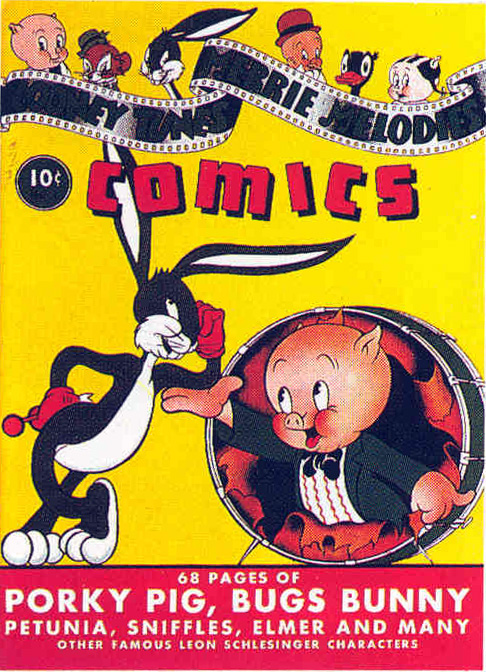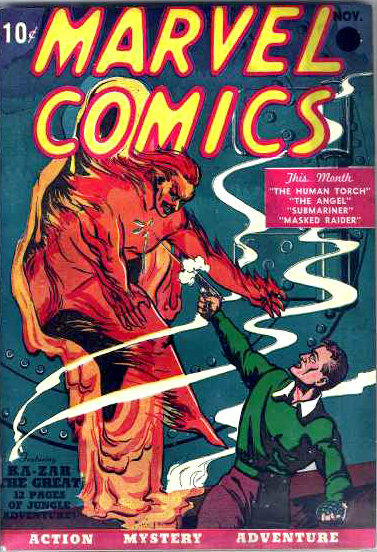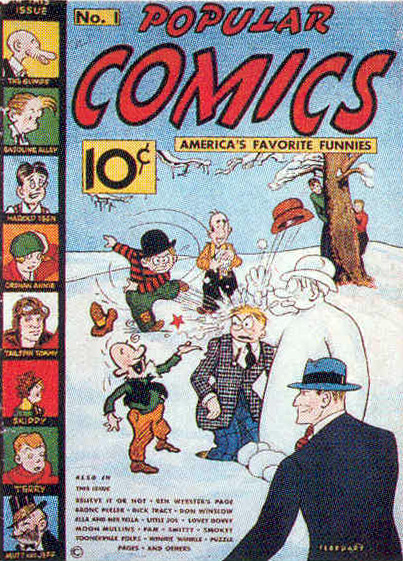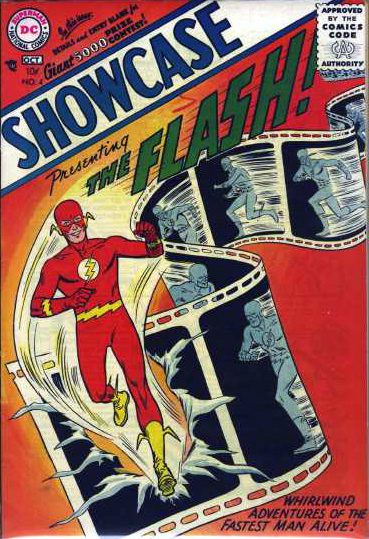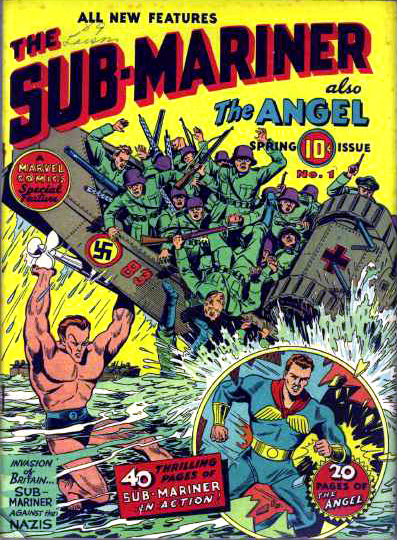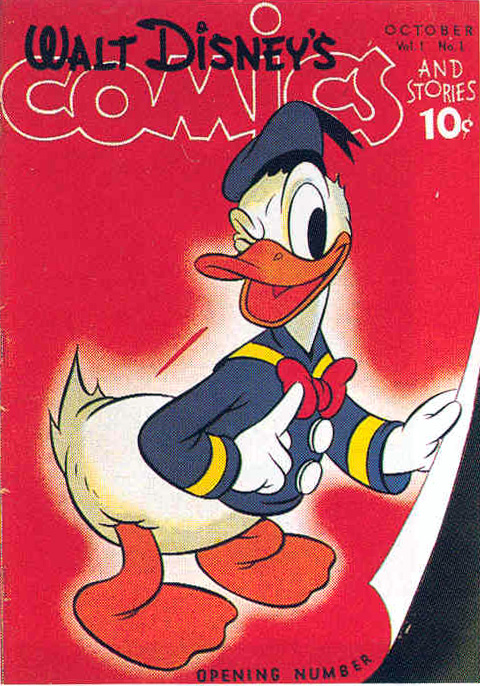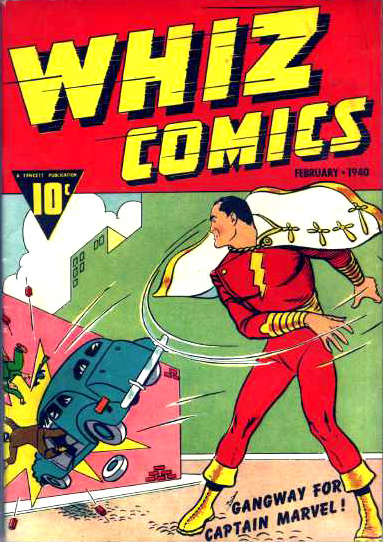
Sometimes the seeds of something big are planted very early. That was the case with Robert M. Overstreet. Known to literally hundreds of thousands of readers as the author of The Overstreet Comic Book Price Guide, Bob not only started with comics early in life, he started with them early each day.
"I read comic books in the late '40s. One of my favorite comics was Fox And The Crow. I would have Kix cereal in the morning and I would read my Fox & the Crow comics eating Kix," he told Scoop. "My older brother Jerry had more comic books than I did. And we always had comic books around the house."
Since its first publication in 1970, The Overstreet Comic Book Price Guide established a standard for price guides in many fields. With the book's 33rd edition due out next month, Scoop sat down with Bob and got to the bottom of how it all started.
You mentioned Fox And The Crow. Were funny animals your favorite?
With my brother's comics I remember Captain Marvel, Daredevil (the '40s Daredevil, that is). It was a mixed bag of superhero and funny animal, but I mainly remember reading the Fox And The Crow comics. I really enjoyed those.
What was your family background? Did your dad have a furniture business?
Dad was in the furniture business. He owned his own store. He worked in the coalmines back in the 1930s in West Virginia. That's where I was born. Then he went to work for Sterchi's, which was a big furniture chain rooted out of Knoxville, TN. They transferred him to Cleveland, Tennessee in 1944.
And that's when you moved there?
Yes. And then he opened his own store after he'd been there a while. Before he opened the store, though, he left Sterchi's and went to work for the newspaper. He became publisher of the Cleveland newspaper between 1948 and 1952. In '52 he opened his own furniture store. He kept that for 10 years and then he sold it. He didn't do well with it. I don't know if he ever showed a profit. Then he sold it and went back to West Virginia in the early '60s.
How old were you when you hit the ECs?
I was 13.
How did you discover them?
I met Landon Chesney when I was in the eighth grade. LC was very intelligent and he collected ECs. He collected them seriously. He loved the art, and he was a great artist himself. I was always interested in art, so when I met him he introduced me to EC Comics. And he also introduced me to the idea of collecting comic books. I never thought about collecting them before that. He was a really interesting person. He collected comics, and was interested in magic. He did a lot of artwork. He was interested in theater. He could imitate almost anybody. In high school he was in theater. He enjoyed that. I would take him to high school parties with me and he'd be the entertainment for the party because he could imitate Jimmy Stewart, or Jerry Lewis or Peter Fontaine or just about anybody famous. He was really good at it. He was a natural.
Did you guys meet other collectors at that point?
We were the two comic book collectors in the town. We had friends that had comic books, but we were the only ones who were serious about it. We were always seeking EC comics to complete our sets, and so we discovered a few EC comics from our friends, but not many.
Once you started getting really diligent about tracking down all the ECs, how did you start meeting other collectors?
Back in the early '50s I also collected coins. I always bought the Red Book when it came out each year. Back in those days, you could still go through change and find a lot of rare coins in it. It wasn't a big investment other than time. So I went to the bank and they would give me the parking meter money, and I would go through it looking for rare coins. And then I would count the coins and roll them for the bank.
So you traded your services for the chance to cherry pick coins from the bank?
Right. I found a lot of rare coins. I put together complete sets of almost all the rare 20th century coins. I would even find Indian Head Pennies or Barber coins going back to the 1800s [editor's note: Barber coins were named after their designer, created as dimes, quarters and half dollars by the Mint from 1892 to1915]. Buffalo Nickels were very common and Jefferson Nickels were very easy to get, even the rare Jefferson 1950 "D" Nickel. I found at least a roll or two of them. I sold them to coin dealers for $2.50 a piece and I was paying 5¢ each. I was really into coins. We would have a Red Book party when the Red Book came out each year there in Cleveland. There was a coin dealer, and we would all get together when the Red Books arrived. We really looked forward to that.
This background was pretty important, I think. At the same time, I was really into EC Comics and trying to locate the back issues, other collectors, dealers, or anyone that had a source for those comics. Pretty early on we met two other collectors in Tennessee. One was Billy Hoover, who lived in Manchester, TN, and he had a comic book mail order business. He sent out price lists of comic books and he collected EC, Disney...
Was he one of the earliest dealers?
He was an early one. He collected all the westerns, some superheroes... he loved the Disneys, he loved Barks, and he loved the ECs. I think his name was on the EC Bulletin that they put out in the early '50s. So we wrote to him, and he wasn't that far away from us so we started corresponding with him. He was also an artist and loved drawing comics. We met him through the mail and then drove over an actually met him in person. He was the first person I bought back issue ECs from. He would type his lists up on tissue paper, on toilet paper, on paper bags, whatever paper he had available. It was weird. I still remember ordering a stack of ECs from him and waiting on that package.
Were these ones you hadn't seen or just upgrading the copies you already had?
I had never seen them.
You must have been really excited then.
I would have dreams about what might be on the covers. We had never seen these early ECs.
Did they live up to your expectations?
Oh, yeah, they were fantastic. They were all early ones. He packaged them in a shoebox and put it in the mail. When the box arrived it didn't survive very well in the postal system. The comics were loose inside the box. There were gaping holes in the box. Probably the comics were damaged, but back in those days you were just happy to have a copy if it was complete, even if today it would be considered VG or whatever.
How long before you started wanting really good copies?
It was long after that. In Tennessee, old comic books were very hard to find. We went to Nashville, Chattanooga, Atlanta, and it seemed like nobody had old comic books. There were very few collectors we knew of in the South. We also met Harry Thomas, another collector, from Sweetwater, TN. He collected superhero comics. We collected the ECs almost exclusively. So Harry introduced us to the superheroes and to the fact that a lot of people around the country collected them. We had a lot of arguments about which were the best. [laughter] We would always argue that ECs were aimed at an older audience and they were better than the superheroes, which were aimed at a younger audience. I remember when we first met Harry he had a few Golden Age comics. And we had never seen any Golden Age comics - there were no used bookstores with them for sale, no one we traded with had them, you just didn't see them in Tennessee. So he brought down a little stack of Golden Age comics. I bought from him an All-Star and a Green Lantern #18, the Christmas cover, and he kind of introduced me to the other types of comics outside of EC. I was desperately trying to put an EC collection together, but funds were limited and that's all I could afford.
At what point did you figure out what you thought you wanted to do for a career?
At that time, I was very interested in astronomy. I was grinding telescope lenses, making telescopes. I had friends in the community, older friends, and one guy owned a machine shop. He was very interested in science and geology. He had has own laboratory in his home. I'd go over and visit him every week. He made me a telescope mount and made my rack and pinion gear at his machine shop. I bought the kit for the mirror and ground my own mirror. It took me two years to grind that mirror. I was learning about how to do that. That was another hobby of mine. I thought that when I grew up I wanted to be an astronomer. I never thought of anything else. I was always out late at night with the telescope. Later, I got a camera and learned how to take pictures through the telescope. Some of these pictures were actually published in an astronomy magazine back in the '60s. I didn't know the pictures had been published. A local person called me and asked me if I was the Bob Overstreet that took the pictures he had seen in this book he bought. That was the first I had heard of it, so I ran to the bookstore, found the book, and there were my pictures.
How did they get the photos?
After I built my own, I bought a good quality telescope. I sent the pictures to the telescope company. They had them published.
What were you doing for a job at that point?
Working for my dad at the furniture store. I was the credit manager and the bookkeeper.
So you did that until he sold the business?
Yes. Then I was put out on the street. [laughter] I moved around from one job to another. My training was bookkeeping. I got a selling job, which I hated. I was never a salesman. Then I got a bookkeeping job and then a credit job. Then finally I got a really good job at Bowater Paper Company, one of the largest employers in our area and one of the biggest paper plants in the country. They were close by, and they ran an ad for a statistician. I applied and got it. I launched the price guide while I was there.
So you were gaining knowledge of printing at that point. Did that help with the price guide?
Well, while my dad was publisher of the newspaper they also did job printing. I guess I had ink in my blood. He was really strong in advertising and he convinced me that I needed to sell ads for my first price guide, so that's what I did.
And your book was the first price guide to carry advertising in it?
Certainly in this hobby, but I had never seen another one with ads in it even in other fields.
Before you started actually putting the price guide together, was there one exact moment when you knew you had to do it, or was there a series of events that lead you to consider it?
I think it was several years of slowly discovering other collectors in the area and then around the country. We discovered science fiction fandom in the early '50s.
And they were much more organized than comics were at that point?
They were organized, and they were putting out newsletters. There was one guy in Dalton, Georgia, 30 miles away, who was in science fiction fandom. The guy who was the president of that group was in Birmingham, Alabama. And Chesney went down to see him, and his name was Alfred McCoy Andrews. From science fiction fandom we got names of people who had comic books. So we joined that group so we could locate other collectors, who shared our interest. When Chesney and I were high school we spent a lot of our time writing and drawing comic books.
You did an extensive article in CBPG #30 about that.
Right. So we drew some stories and published some of them. Among them was this one story that I republished in that article. At the end of that story we wrote in Alfred McCoy Andrews' name on a newspaper as a tribute to him. But we also met another collector down in Georgia, down below Atlanta, and he collected horror. He had almost every horror comic. And we went down and met him. He had ECs and everything else, and he also had some superhero comics. I remember trading him a duplicate EC I had for a Superman #2. And we thought, "Who knows? This may be worth something someday." I was a little reluctant to give up an EC for a superhero comic, but I picked that book up and thought it was kind of neat. We went down to see this guy a couple of times. He had walls of paperbacks. He had all the comic books on bookshelves, stood up on end, and he had gone through and taped the spines on all of his comics with Scotch tape.
Ouch.
So his whole collection was ruined. So we met a lot of people and found new sources. This went on all through the '50s and '60s.
As you had this network of people, is there one point where you think there's just got to be a price guide...?
All through the '60s I was hoping that someone would put out a price guide on comic books because one was needed.
Did you recognize that because of your experience in coins?
Yes. I wanted to see a Red Book in comics. I didn't know if it would ever happen. I didn't know if comics would ever become a legitimate collectible field like coins. I was hoping it would. I was hoping that someone would someday put out a guide on comics. I just didn't know it was going to be me.
What brought you to the point of deciding it was going to be you?
The comic market was really taking off in the '60s. Prices were escalating rapidly. Almost any 10¢ comic was worth money. You had the Rocket's Blast - Comic Collector (RBCC) coming out and going to all the comic people, and I subscribed to that. I had all the RBCCs and I also had all the price lists from the early dealers like Claude Held and Howard Rogofsky. I could see the market was growing. Like I said, prices were escalating. There were a lot of details that were basically unknown and there was still a lot to be discovered about comics, and there was no single source of information to go to in those days.
I was buying everything off the stands in the '60s beginning with Spider-Man #1, so I had all this stuff. I had a great inventory of Silver Age books. I bought duplicates, so I set up Sonny Johnson to be a dealer. I gave him an inventory to get him started. He ran and ad and the comics sold just like that. I couldn't believe how fast they went. Then I decided I better stop selling the books. They were still going up in value. He sold my two copies of Spider-Man #1, so I didn't get them back.
I also had a relic collection because I hunted arrowheads all through the '50s. The relic market was flat during the '60s while the comic market was taking off. So I sold most of my relics to raise money to buy comics. In the mid '60s I actually started working on an arrowhead price guide. I was going to draw each arrowhead. Instead of using photography, I was going to illustrate each point because that's how all the books down in that market were done. Many of them still are today, in fact. I started doing the research on the types, doing the drawings and so on. I was actually getting into the book. But the comic market was getting so hot...
Then there was a big collection that turned up in 1967. Sonny found this big collection of Golden Age comics in Pennsylvania. He was paying $2.50 a piece for them. The guy who had them was sending him a list every week, and he was picking out the best ones. He didn't buy them all. He bought the #1s and the more valuable ones for $2.50. So he had a box of comics coming in every week. This was all stuff none of us had ever seen. And this was all the Action, More Fun, Superman, Adventure, Detective, All-Star, All-American, Daredevils, reprint comics from the '30s and '40s. One weekend he got Superman #1, All-Star Comics #3 and Detective Comics #27, all at the same time. I was sitting there with not a lot of money, so I was selling everything I could to buy these books. At that time I had a stack of EC annuals. There was a guy in Florida who put out an EC fanzine. He stopped through Cleveland back in the '50s and he gave me a stack of EC annuals. So I sold and traded some of the annuals for those comics. Sonny became a national dealer almost overnight because of that Golden Age collection. He sold to other dealers and collectors all over the country.
In of all this, you realize that there's not only a need for a guide, it was going to take someone to get it started.
I began putting together the page format of what the book would look like, and what would go in the book. I was showing it to Harry, LC, Sonny, and Bob Jennings in Nashville, who put out the fanzine Comic World. I was trying to get somebody interested in putting out a price guide because we needed one. I kept working on it. I kept typing up information, putting it in price guide form and showing it around to people. Nobody wanted to do a price guide. It was too much work. They kept on kicking it back to me. "Why don't you do it?" they said. "We'll help you." [laughter] So finally I ended up doing it.
Aside from the guys you just mentioned, did anyone else have an input into how it looked or what went into it?
Jerry Bails, of course, was another one that I kept sending information to. He was the one I wanted to do it.
Were they all supportive of what you showed them?
Yes.
As long as you were the one doing the work?
Right. [laughter] Bails said he would help me. He had other interests. He was more interested in continuing his research. He didn't want to do a price guide.
Once you began, did they still help?
They all faded out once the work started. I was typing up complete pages and sending them to Jerry. He would lay onionskin paper over my pages and make notations as to what he thought the prices would be. That got to be too much work and he only did a few pages, then he quit. But I had his good wishes to go ahead and do it myself. [laughter]
Over the years since the first guide, you've developed an extensive network of advisors, but what did you base the original prices on?
I went through every piece of information that I had accumulated up to that time, which was quite a few years worth of material. I had a lot of price lists, all the back issues of RBCC, Bill Thailing's catalogs, fanzines and every other bit of information I had. One price list I got from the beginning was from Bob's Book Barn. They sold everything. That's where I got a lot of initial information as to what existed because they would list titles, issue numbers and very importantly dates, which a lot of people didn't list. That was good information. I began setting up an index card file for every title I could find. I would put the information on them.
Did you start seeing the first indications of the regionalism in the market then?
No, that was something that we didn't really see until the market became more national. That wasn't even something we thought about in the early stages.
Who were some of the others you had lists from?
There were a lot of people who advertised in RBCC. I had a lot of individual price lists of collectors. I still have a lot of correspondence from when I was seeking back issue ECs. I corresponded with a lot of collectors. I actually wrote to everybody listed on the EC Bulletins, every one of those people. I found one guy who still had his set of ECs out of all those names. I began buying his back issue ECs. He said he paid through the nose for them, so they were going to be expensive. He was going to have to have a dollar a piece for them. I bought all the rare ones and the early ones, then I got him down to 50¢ on the next batch. Then I tried to get him down to a quarter, and that's when I lost him.
What was the print run on the original Guide?
The print run on the first book was 1,000, and on the second edition it was 800.
How did you come up with the retail price of the book?
I just felt that $5 was a fair price. I sold a lot of copies at a pre-publication price, which was less. I can't remember what that was.
How did you gauge your success?
RBCC was going to about 2,000 people at the time, so I thought my audience was 2,000 people. If I could sell 2,000 copies I would have hit a home run. I did sell about 1,800 copies.
How was it printed?
It was a very small printer who was doing the book. He would run off the pages and then bring them over to my house, and then I had to fold them, collate them, and staple them. I had to do that myself. All he did was the actual printing.
Why did the second printing have a blue cover?
I went to a blue cover because the printing was so bad. The black ink was washed out on a lot of the copies. I thought if I put a color in the background that would minimize the washed out black. That's why I went to blue.
How did the book sell initially?
It came out in the fall. It took me through 1971 to sell out the first two printings, then I started coming out in Spring with the second edition and the Guide has been there ever since.
Did you make corrections between the first and second printings of the first Guide?
Yes. I can't remember what they were specifically, but there were mistakes in the first edition and we corrected the most glaring ones. I retyped those pages on the reprint. I was getting feedback immediately when I was shipping books out.
What were the reactions to the book from collectors and dealers?
That's the first time anyone had put comic book retail values in a book and published it. There was a lot of criticism about the prices being too high, and there was a lot about them being too low. But everybody bought the book. That was the main result; the book was accepted. I remember Phil Seuling, who was throwing the New York conventions, didn't support the price guide until I had put out four editions. Then he was interested in buying it. He started distributing it after that. It took several years before some of the other powerful people in the market began accepting it.
When you put out a price guide, most people don't respond directly to you at all. They'll talk about the book to someone else, and that other person might call you and tell you about it if you're lucky. Bruce Hamilton was one person who got involved after the first guide. He came to see me right after it came out. He drove to Tennessee. It really got him. He became one of my early advisors, and he still is with us. He was very important in the early development of the price guide. He helped a lot in pricing theory, among other things.
When you look back on it, did you ever still expect to be doing it in 2003?
When I did the first book, I didn't think I'd have to do another one. [laughter] The first book was a lot of work. I didn't know... I hadn't thought that much about the future. I hadn't thought about having to do this book every year.
Were you hoping that professional publisher would come along, take over, and do it like the Red Book?
Oh, yeah. There was a point after a few years that I sent copies to major publishers and tried to get them to take it. They all turned me down and said the market didn't need a book like that. Because the first one was such a success, though, there had to be a second. And the second one was twice as successful as the first one, and that meant there had to be a third one. The circulation of the guide was increasing every year. I really had the proverbial tiger by the tail. I was stuck with it, making enough money to keep it going. I couldn't drop it. The most amusing thing to me when I put out the first Guide was that every day when I went to the mailbox there was a check. I couldn't believe that it was so easy. You just run an ad... and all these people send money in. That's what made it great because it eventually gave me the freedom to do this full time.
You can mouse-over the comics pictured with this article to see their prices in the 1970 edition of The Overstreet Comic Book Price Guide. Remember, when Bob first published the book, there were a lot of complaints that the prices were too high!



















